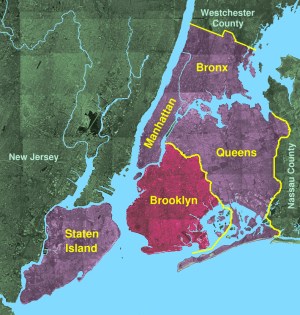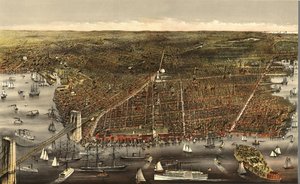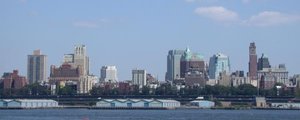Brooklyn
|
|
- For other meanings, see Brooklyn (disambiguation).
Brooklyn-bridge-1890.png
Map_of_New_York_highlighting_Kings_County.png
Brooklyn is the most populous of the five boroughs of New York City. With about 2.5 million inhabitants, it would be the fourth largest city in the United States all by itself, were it a city. An independent city prior to 1898, Brooklyn developed out of the small Dutch-founded town of "Breuckelen" on the East River shore, named after Breukelen in the Netherlands.
Kings County, coterminous with Brooklyn, is also the most populous county in New York. It was named in honor of King Charles II of England.
Variously called the "City of Trees", "City of Homes" or the "City of Churches" in the 19th century, Brooklyn is now often styled the "Borough of Homes and Churches."
| Contents |
Geography
Brooklyn is located in the westernmost part of Long Island. It shares its only land boundary with Queens to the northeast. This boundary is defined in its westernmost section by Newtown Creek, crossed by Kosciusko Bridge and Pulaski Bridge, which flows into the East River.
Following the waterfront south and then counterclockwise from Newtown Creek, the lower East River forms the northern coast of Brooklyn, with connections to Manhattan at Williamsburg Bridge, Manhattan Bridge, the Brooklyn Bridge and the Brooklyn-Battery Tunnel. The western coast lies on Upper New York Bay and features the Red Hook peninsula and the Erie Basin, home to a container port, and separated from Governors Island by Buttermilk Channel. South of this is Gowanus Bay, connected to the Gowanus Canal. At its westernmost section, Brooklyn is closest to Staten Island at the Narrows, and the two are connected there by the Verrazano Narrows Bridge, which separates Upper and Lower New York Bays. The southern coast includes the peninsula encompassing Coney Island and Brighton Beach. The southeastern coast lies on island-filled Jamaica Bay and is connected to Rockaway by the Marine Parkway-Gil Hodges Memorial Bridge, named after the Brooklyn Dodgers' first baseman who made his home in the borough.
The highest point of Brooklyn is the area around Prospect Park and Green-Wood Cemetery, rising approximately 200 feet above sea level. There is also a minor elevation in Downtown Brooklyn known as Brooklyn Heights.
According to the United States Census Bureau, the County has a total area of 251.0 km² (96.9 mi²). 182.9 km² (70.6 mi²) of it is land and 68.1 km² (26.3 mi²) of it is water. 27.13% of the total area is water.
History
Six Dutch Towns
The Dutch were the first Europeans to settle in the area that is today Brooklyn, a western part of Long Island then largely inhabited by the Canarsee Native American tribe. The area was considered a part of New Netherland, and the Dutch West India Company lost little time in chartering the six original towns (listed here first by their later, more common English names):
- Gravesend: in 1645, settled under Dutch patent by English followers of Anabaptist Lady Deborah Moody
- Brooklyn: as "Breuckelen" in 1646, after the town now spelled Breukelen, Netherlands
- Flatlands: as "New Amersfoort" in 1647
- Flatbush: as "Midwout" in 1652
- New Utrecht: in 1657, after the city of Utrecht, Netherlands
- Bushwick: as "Boswijck" in 1661
Toward a United City of Brooklyn
What is today Brooklyn left Dutch hands after the English conquest of New Netherland in 1664, to become a part of the colony of New York.
The English organized the six old Dutch towns of southwestern Long Island as Kings County in 1683, one of twelve counties then established in New York. This was the first time that tract of land was ever recognized as a political entity, and laid the municipal groundwork for a later expansive idea of Brooklyn identity.

On August 27, 1776, the Battle of Long Island (also known as the Battle of Brooklyn) was the first major engagement fought in the American Revolutionary War. British troops forced Continental troops off the heights near the modern site of Grand Army Plaza. The American positions at Brooklyn Heights consequently became untenable and were evacuated a few days later, leaving the British in control of New York Harbor.
The surrounding region was controlled by the British for the duration of the war, and the British military was largely supported by a dominant Loyalist sentiment in Kings County. New York only changed from a British colony to an American state with the Treaty of Paris in 1783.
The first half of the 19th century saw the beginning of the development of urban areas on the economically strategic East River shore of Kings county, facing the adolescent City of New York confined to Manhattan Island.
The first center of urbanization sprung up in the Town of Brooklyn, directly across from Lower Manhattan, which saw the incorporation of the Village of Brooklyn in 1816. Town and Village were combined to form the first, kernel incarnation of the City of Brooklyn in 1834.
In parallel development, the Town of Bushwick, a little farther up the river, saw the incorporation of the Village of Williamsburgh in 1827, which separated as the Town of Williamsburgh in 1840, only to form the short-lived City of Williamsburgh in 1851.
But the East River shore was growing too fast for the three-year-old infant City of Williamsburgh, which, along with its Town of Bushwick hinterland, was subsumed within a greater City of Brooklyn in 1854.
Taking a thirty-year break from municipal expansionism, this well-situated coastal city established itself as the third-most-populous American city for much of the 19th century. As 'Twin City' to New York, it played a role in national affairs that is only now shadowed by its modern submergence into its old partner/rival.
Throughout this period the peripheral towns of Kings County, far from Manhattan and even urban Brooklyn, maintained their rustic independence. The only municipal change seen was the secession of the eastern section of the Town of Flatbush as the Town of New Lots in 1852. The building of rail links like the Brighton Beach Line in 1878 heralded the end of this isolation.
Toward the end of the 19th century, the City of Brooklyn experienced its final, explosive growth spurt. In the space of a decade, it annexed the Town of New Lots in 1886, the Town of Flatbush, the Town of Gravesend, and the Town of New Utrecht in 1894, and the Town of Flatlands in 1896.
Brooklyn had reached its natural municipal boundaries at the ends of Kings County. The question was now whether it was prepared to engage in the still-grander process of consolidation now developing throughout the region.
Brooklyn as New York Borough
In 1898, Brooklyn joined with Manhattan, the Bronx, Queens and Richmond (later Staten Island) as the five boroughs to form the modern City of Greater New York. Kings County retained its status as one of New York State's counties.
Neighborhoods of Brooklyn
Brooklyn_Neighborhoods.PNG
Brooklyn, the 'Borough of Homes', can be understood as a collection of neighborhoods, many historically descended from the old towns and villages of Dutch times. The borough's striking diversity plays host to a bustle of ethnic and multi-ethnic neighborhoods that both preserve a flavor of 'the old country', of whatever latitude, and create spaces for interaction between individuals and communities. So for illustration, Borough Park is largely Orthodox Jewish, Bedford-Stuyvesant African American, Bensonhurst Italian American, and Sunset Park Hispanic.
Most sections of Brooklyn are indeed decidedly residential, fulfilling the borough's historic role as 'bedroom of New York'. This symbiotic mating of the residential city with the business center of Manhattan has profoundly shaped Brooklyn from its beginning, and only accelerated with the building of the Brooklyn Bridge and other connections, to the near-death of Brooklyn industries and a winnowing of commerce to a basic consumer level in the years following World War II. It is only at the start of the 21st century that business and industry have begun to revive around the borough amid something of a general renaissance.
Many Brooklyn ethnic neighborhoods established in the first half of the 20th century developed as offshoots of second-generation Americans escaping the slums of Manhattan. Today, however, new immigrants are just as likely to set down their first American roots in Brooklyn. The constant inward movement of new immigrant groups, as well as the expanding horizons of longer-established groups, set a dynamism on the map of Brooklyn's neighborhoods.
In recent years a series of artists' colonies have developed along the East River across from Manhattan as a refuge for artists fleeing the sky-high rents of SoHo. Such was the development of the artistic community in Williamsburg, with consequent recent rent hikes there spurring a further exodus, to DUMBO (Down Under Manhattan Bridge Overpass), and even to Red Hook.
Brooklyn-borough-hall.jpg
Borough and state government buildings are mostly found in the Brooklyn Civic Center area (including Brooklyn Borough Hall and Kings County Supreme Court) in downtown Brooklyn, near the Brooklyn Bridge and Brooklyn Heights.
See: List of Brooklyn, New York neighborhoods
Demographics
As of the censusTemplate:GR of 2000, there are 2,465,326 people, 880,727 households, and 583,922 families residing in the County. The population density is 13,480/km² (34,920/mi²). There are 930,866 housing units at an average density of 5,090/km² (13,180/mi²). The racial makeup of the County is 41.20% White, 36.44% Black or African American, 0.41% Native American, 7.54% Asian, 0.06% Pacific Islander, 10.08% from other races, and 4.27% from two or more races. 19.79% of the population are Hispanic or Latino of any race. 34.7% of the population are Whites not of Hispanic origins.
In the 2000 Census, the following percentages of Brooklyn residents self-reported these European ancestries:
According to an estimate of the Census Bureau, population increased to 2,472,523 in 2003.
There are 880,727 households out of which 33.3% have children under the age of 18 living with them, 38.6% are married couples living together, 22.3% have a female householder with no husband present, and 33.7% are non-families. 27.8% of all households are made up of individuals and 9.8% have someone living alone who is 65 years of age or older. The average household size is 2.75 and the average family size is 3.41.
In the County the population is spread out with 26.9% under the age of 18, 10.3% from 18 to 24, 30.8% from 25 to 44, 20.6% from 45 to 64, and 11.5% who are 65 years of age or older. The median age is 33 years. For every 100 females there are 88.4 males. For every 100 females age 18 and over, there are 83.1 males.
The median income for a household in the County is $32,135, and the median income for a family is $36,188. Males have a median income of $34,317 versus $30,516 for females. The per capita income for the County is $16,775. 25.1% of the population and 22.0% of families are below the poverty line. Out of the total population, 34.0% of those under the age of 18 and 21.5% of those 65 and older are living below the poverty line.
Kings County: law and government
Like the other counties which are contained within New York City, there is no separate county government per se though there is a Borough President's office that is part of New York City government and various Community Boards that have authority over specific neighborhoods. Democrat Marty Markowitz is currently Borough President. Unlike other counties outside New York City, County Courts do not exist there; they have been replaced by New York City Civil Court that deals with small claims, lawsuits under $25,000 and housing cases. Other state offices such as the district attorney (public prosecutor) are organized as in other non-New York City counties.
Sports and Recreation
Baseball
Brooklyn has been a hotbed of baseball going back to the sport's infancy. A box score from October 21, 1845, lists a game between the New York Base Ball Club and "Brooklyn Players". The New York Base Ball Club was one of the first to play under rules codified by Alexander Cartwright.
With the advent of professional baseball in 1871, Brooklyn hosted three teams in the first pro league, the National Association: the New York Mutuals, the Brooklyn Eckfords, and the Brooklyn Atlantics. All three played at Union Grounds in Williamsburg. The Mutuals also used the field in 1876, the first year of the new National League; so did the Hartfords of Brooklyn in 1877.
Brooklyn's most famous team, the Dodgers, got its start in 1884 in the American Association, calling themselves the Bridegrooms and playing at the first of three venues called Washington Park. The team moved to the National League in 1890 and relocated to Ebbets Field in 1913. In the years prior to 1932, they were also known as the Superbas and the Robins, the last an informal name taken from their manager, Wilbert Robinson. In 1955, the Dodgers won their first and only World Series in Brooklyn, beating their longtime rival, the New York Yankees, resulting in mass euphoria and celebrations all over Brooklyn. Just two years later, the Dodgers moved to Los Angeles, California, after the 1957 season, causing widespread resentment and sorrow. Brooklyn's most beloved and cherished institution had left, and the move is cited by some historians as one of the catalysts for the decline of Brooklyn in the 1960s and 1970s.
In addition, the Brooklyn Wonders of the Players League in 1890 and the Brook-Feds of the Federal League in 1914 and 1915 called the borough home.
After a 43-year hiatus, baseball returned to the borough in the form of the Brooklyn Cyclones, a minor league team that began playing on Coney Island in 2001. The Cyclones are a Single A affiliate of the New York Mets Major League Baseball team. The Cyclones play at Keyspan Park, located in southern Brooklyn near the Coney Island boardwalk. During hot summer nights, fireworks are sometimes used to signify the commencement of the baseball games.
Football
Several professional football teams have called Brooklyn home, including two in 1926. The Brooklyn Horsemen of the original American Football League and the Brooklyn Lions of the National Football League competed for a time before merging in November and folding at season's end.
In 1930, the Brooklyn Dodgers began play at Ebbets Field. The team lasted until 1944, calling themselves the Brooklyn Tigers that last season but going winless and leaving the NFL.
The second AFL also had a Brooklyn Tigers club in 1936; it played seven games before folding.
In 1946, the new All-America Football Conference had yet another Brooklyn Dodgers team. This club lasted until 1948, after which it merged with the New York Yankees football team.
Finally, there was an independent minor league team called the Brooklyn Dodgers in the Continental Football League in 1966. They played a 14-game schedule and then folded as well.
Basketball
On January 23, 2004, developer Bruce Ratner announced that he had purchased the New Jersey Nets of the National Basketball Association. He plans to move the Nets to a new, 20,000-seat Brooklyn Nets Arena as part of a development called at the Atlantic Yards at Flatbush and Atlantic Avenues. Brooklyn is also receiving a team in the new American Basketball Association in 2005. They will be called the 'Heat'.
Symbols and Nicknames
The Dutch language motto is Een Draght Mackt Maght, after that of the United Dutch Provinces, usually translated as In Unity, There is Strength. The motto is displayed on the civic seal and flag, which also feature a young robed woman bearing fasces, a traditional emblem of republicanism.
Residents of Brooklyn are known as Brooklynites, and their sometimes distinctive Brooklyn accent has been jokingly labeled Brooklynese.
Brooklyn Sites and Institutions
- Atlantic Avenue Tunnel
- Brooklyn Academy of Music
- Brooklyn Borough Hall
- Brooklyn Botanic Garden
- Brooklyn Bridge
- Brooklyn Children's Museum
- Brooklyn Historic Railway Association
- Brooklyn Historical Society
- Brooklyn Law School
- Brooklyn Museum
- Brooklyn Public Library
- Ebbets Field
- Fort Greene Park
- Fort Hamilton Museum
- Grand Army Plaza
- Green-Wood Cemetery
- New York Aquarium
- New York Transit Museum
- Old Stone House
- Plymouth Church
- Pratt Institute
- Prospect Park
- Prospect Park Zoo
External links
- The official web site of the Brooklyn Borough President (http://www.brooklyn-usa.org/)
- The Brooklyn Eagle, 1842-1901 (http://www.brooklynpubliclibrary.org/eagle/) (from the Brooklyn Public Library)
- Brooklyn Statistics (http://www.bedc.org/bkstats.htm) from the Brooklyn Economic Development Council.
- Digitalbrooklyn (http://www.digitalbrooklyn.com) Comprehensive Community and Event Information
- Brooklynx (http://www.brooklynx.org/): Information and Culture
- Brooklyn Young Republican Club (http://www.brooklynyr.com/)
- Brooklyn population (http://www.longislandexchange.com/brooklyn_ny.html),
- Fort Greene Park Conservancy (http://www.fortgreenepark.org)
- Brooklyn Irish American Parade (http://www.brooklynirishamericanparade.com)
- NYC MTA Transit Bus Map of Brooklyn (http://www.mta.nyc.ny.us/nyct/maps/busbkln.pdf) (pdf file)
- Bicycle Map of Brooklyn (http://www.transalt.org/maps/bkmap.pdf) (pdf file)
pt:Brooklyn de:Brooklyn et:Brooklyn es:Brooklyn eo:Broklino fr:Brooklyn it:Brooklyn he:ברוקלין nl:Brooklyn ja:ブルックリン地区 no:Brooklyn simple:Brooklyn sl:Brooklyn sv:Brooklyn zh:布鲁克林




